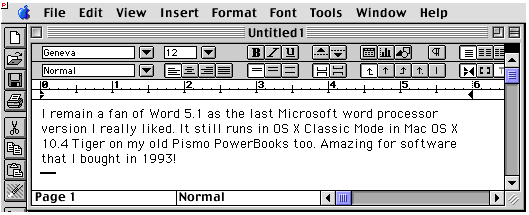
- #MICROSOFT WORD RELEASE HISTORY FOR MAC FOR FREE#
- #MICROSOFT WORD RELEASE HISTORY FOR MAC HOW TO#
- #MICROSOFT WORD RELEASE HISTORY FOR MAC INSTALL#
- #MICROSOFT WORD RELEASE HISTORY FOR MAC SOFTWARE#
- #MICROSOFT WORD RELEASE HISTORY FOR MAC DOWNLOAD#
Step 5: Rename the generated MS Word binary from “Signintoyouraccount” to “word.” cd ~/microsoft-word Step 4: Rename the output folder from “Signintoyouraccount” to “microsoft-word.” mv ~/Signintoyouraccount-linux-圆4/ ~/microsoft-word/ nativefier -p linux -a 圆4 -i icon.png -disable-context-menu -disable-dev-tools -single-instance -internal-urls ".*" Step 3: Run the nativefier command to build the Microsoft Word app.
#MICROSOFT WORD RELEASE HISTORY FOR MAC DOWNLOAD#
Step 2: Use the wget tool to download the Microsoft Word icon. It is required to build Microsoft Word on Linux. Step 1: Using the npm command, set up the latest Nativefier. With Nativefier installed, follow the step-by-step instructions to get Microsoft Word working on your Linux PC.
#MICROSOFT WORD RELEASE HISTORY FOR MAC INSTALL#
Ubuntu sudo apt install npm Debian su -Īpt-get install -y nodejs Arch Linux sudo pacman -S npm Fedora sudo dnf install npm OpenSUSE sudo zypper install npm To start the installation, open up a terminal window and get the latest NodeJS working on your Linux computer. Thankfully, it is possible to create your own Linux Microsoft Word app with the Nativefier tool. While the Snap method for Microsoft Word is effortless, not everyone can run Snap packages. From here, click the “New blank document” button to start writing. Step 4: Upon logging in to the app, you will see the Microsoft Word UI. If you do not have an MS account, click the “Create One” button. Use the UI and log in to your Microsoft account. Instead, you will see a Microsoft “Sign in” page. Step 3: When Word launches on the Linux desktop, you will not be presented with the wordprocessor UI. Or, find the “Office” section, and click on the “Word” icon. Step 2: In the app menu, type in “Word” in the search box to run a search for the Microsoft Word shortcut. Alternatively, click on the launcher menu button on the panel with the mouse. Step 1: Open up the app menu on your Linux desktop by pressing Win on the keyboard. Using Wordįollow the step-by-step instructions below to get access to Microsoft Word.
#MICROSOFT WORD RELEASE HISTORY FOR MAC HOW TO#
With the “Unofficial-webapp-office” application installed onto your Linux PC via Snap package, move on to the next section to learn how to use Word on Linux. sudo snap install unofficial-webapp-office From here, you’ll be able to install Word with the following snap install command below. When the Snapd runtime is enabled on your Linux PC, Snap packages are ready to use. Alternatively, follow our in-depth guide on how to set up Snapd on your Linux PC.
#MICROSOFT WORD RELEASE HISTORY FOR MAC SOFTWARE#
To enable this runtime, use your Linux PC’s package management tool and install the “snapd” package from the software repositories, and enable snapd.socket it with the systemd init system. The Snap package installation for Word begins by enabling the Snapd runtime. Then, follow either the Snap or Flatpak instructions outlined below. To start the installation of Word on your Linux PC, open up a terminal window on the desktop by pressing Ctrl + Alt + T or Ctrl + Shift + T on the keyboard. As a result, getting Microsoft’s famous wordprocessor working is effortless. It’s a simple web-wrapper that delivers the online versions of Microsoft Office to Linux users.Ĭurrently, Word is on Linux with the help of Snap packages, which is supported by about 75% of Linux operating systems. The mobile application also provides free access to basic editing features from your pocket, and all of this only requires a Microsoft account to keep everything in sync.For those looking to get going with Microsoft Word on Linux, the best way to go is with the “unofficial-webapp-office” package.

The development of the browser-based application for Windows 10, Mac, Linux, and Chrome OS users makes it easy and convenient to work solo or in collaboration. Not only is there no requirement to pay to use Microsoft Word anymore, but there’s also no requirement to even install it if you’re using it on a PC.
#MICROSOFT WORD RELEASE HISTORY FOR MAC FOR FREE#
Previously, Microsoft had a standalone Word app for both iOS and Android, but it has now merged Word with Excel and Powerpoint on mobile in the single Microsoft Office application.Īgain, to use it you only need to log in with a Microsoft account for free access to basic features, as well as online collaboration, backup to OneDrive, and the ability to create PDF files from your documents. Using Microsoft Word on a smartphone or a tablet might not be your first choice, but it’s possible and it’s also free.


 0 kommentar(er)
0 kommentar(er)
